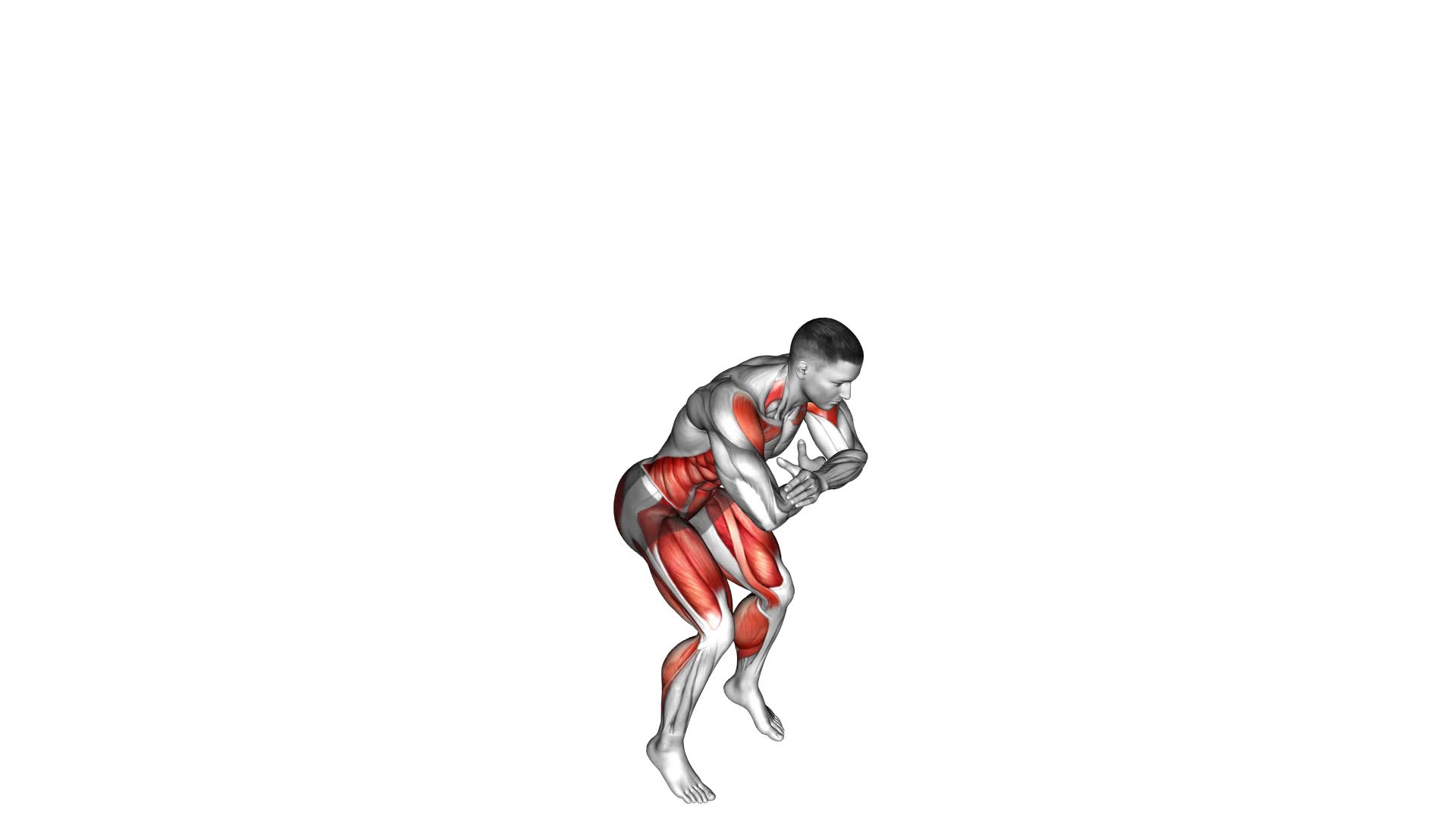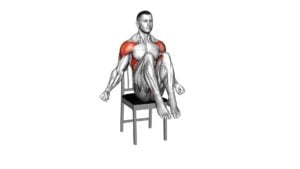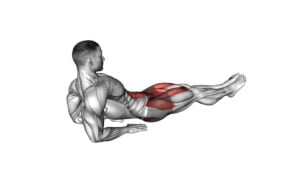Knee Tuck Jump – Video Exercise Guide & Tips

Are you looking for an effective way to amp up your workout routine? Look no further than the knee tuck jump!
Watch This Exercise Video
This explosive exercise targets your lower body muscles, helping to tone and strengthen them.
In this article, we will provide you with a video exercise guide and valuable tips to ensure you perform knee tuck jumps with proper form and technique.
Get ready to take your fitness to the next level with this challenging yet rewarding move.
Key Takeaways
- Knee tuck jumps improve explosive power and strengthen lower body muscles
- Engaging core and maintaining proper form is crucial for injury prevention and protecting the spine
- Prioritizing a stretching and warm-up routine before knee tuck jumps is important for safety and muscle coordination
- Gradually progressing and incorporating variations can keep the routine interesting and reduce the risk of overexertion and injury.
Benefits of Knee Tuck Jumps
Improve your explosive power and strengthen your lower body with knee tuck jumps. Incorporating knee tuck jumps into your workout routine can provide you with numerous benefits, including injury prevention and a variety of workout routine ideas.
One of the key benefits of knee tuck jumps is injury prevention. By engaging the muscles in your lower body, including your quadriceps, hamstrings, and glutes, knee tuck jumps help to strengthen and stabilize these muscles, reducing the risk of injuries such as sprains and strains. Additionally, knee tuck jumps also improve your balance and coordination, further enhancing your ability to prevent injuries during physical activities.
Furthermore, knee tuck jumps offer a range of workout routine ideas. You can perform them as a standalone exercise or incorporate them into a circuit training routine. For example, you can combine knee tuck jumps with other bodyweight exercises like push-ups, lunges, and planks to create a high-intensity interval training (HIIT) workout. This not only helps to target multiple muscle groups but also adds a cardio element to your routine, boosting your overall fitness level.
Incorporating knee tuck jumps into your workout routine is an effective way to improve your explosive power and strengthen your lower body. With their injury prevention benefits and versatility in workout routine ideas, knee tuck jumps are a valuable addition to any fitness regimen.
Proper Form and Technique
To ensure proper form and technique when performing knee tuck jumps, it's important to focus on maintaining a strong core throughout the exercise. This will help you maintain stability and control as you execute the movement. Start by standing with your feet hip-width apart and your arms extended in front of you. Bend your knees slightly and then explosively jump up, bringing your knees towards your chest. As you tuck your knees, engage your abdominal muscles to maintain balance and control.
At the peak of the jump, try to hold the tucked position for a brief moment before landing softly on the balls of your feet. Remember to keep your back straight and avoid hunching over. It's crucial to land with your knees slightly bent to absorb the impact and protect your joints.
To ensure you're performing knee tuck jumps with proper technique, there are a few common errors to avoid. One of the most common mistakes isn't fully extending your legs during the jump. Make sure to fully straighten your legs as you jump up to maximize the effectiveness of the exercise. Another mistake is allowing your knees to collapse inward as you land. Focus on keeping your knees in line with your toes to avoid unnecessary stress on the joints. Lastly, avoid using your arms to swing excessively during the jump, as this can throw off your balance and compromise your form.
Now that you understand the proper form and technique of knee tuck jumps, let's discuss some common mistakes to avoid.
Common Mistakes to Avoid
When performing knee tuck jumps, it's important to avoid these common mistakes to ensure proper form and maximize the effectiveness of the exercise.
One common mistake isn't engaging your core muscles. Your core plays a crucial role in stabilizing your body during the jump, so it's important to tighten your abs and keep them engaged throughout the movement.
Another mistake to avoid isn't landing softly. When you land, make sure to bend your knees and absorb the impact with your leg muscles. This will help prevent unnecessary strain on your joints and reduce the risk of injury.
Additionally, many people tend to rush through the exercise and sacrifice proper technique. It's important to maintain control and perform each jump with proper form.
Finally, avoid leaning forward or rounding your back during the jump. This can put strain on your lower back and compromise your form. Instead, keep your chest up and maintain a neutral spine throughout the movement.
Modifications and Progressions
Now let's talk about the modifications and progressions you can make with the knee tuck jump exercise.
If you're a beginner, there are easier modifications you can try to build up your strength and technique.
On the other hand, if you're more advanced, there are progressions that can challenge you even further.
Both modifications and progressions offer unique benefits that can help you improve your fitness level and reach your goals.
Easier Modifications for Beginners
Start with modified versions of the knee tuck jump to make it easier for beginners. If you're just starting out or want to build up your strength before attempting the full exercise, there are several beginner-friendly options to try.
One modification is to perform a knee tuck without the jump. Start in a standing position, then bring one knee up towards your chest while balancing on the other leg.
Another option is to perform a seated knee tuck. Sit on the edge of a chair with your feet flat on the floor. Lift one knee towards your chest, then extend the leg back out.
These easier modifications allow you to work on the movement and engage your core without the intensity of the full jump.
Advanced Progressions for Experts
To further challenge yourself and continue progressing with the knee tuck jump, you can explore advanced modifications and progressions. These advanced modifications are designed to push your limits and enhance your explosive power training.
One advanced modification is the weighted knee tuck jump, where you hold a dumbbell or kettlebell in your hands while performing the jump. This adds resistance and increases the intensity of the exercise.
Another progression is the single-leg knee tuck jump, where you perform the jump on one leg instead of both. This variation requires even more strength and balance.
Benefits of Modifications
To enhance your explosive power training and push your limits even further, incorporate advanced modifications and progressions into your knee tuck jump routine.
These modifications offer several benefits that can take your workout to the next level. By adding variations and modifications, you can target different muscle groups and challenge your body in new ways.
For example, you can try adding a medicine ball or a weighted vest to increase the intensity of the exercise. This won't only help build strength and power but also improve your balance and coordination.
Additionally, modifications allow you to adjust the difficulty level based on your fitness level and goals. Whether you're a beginner or an advanced athlete, incorporating modifications can help you continue to progress and see results.
Safety Precautions and Injury Prevention
To ensure your safety during knee tuck jumps, it's crucial to maintain proper form throughout the exercise. This means keeping your core engaged, landing softly on the balls of your feet, and avoiding excessive forward or backward leaning.
Additionally, it's important to warm up and stretch your muscles before attempting this exercise to prevent injuries such as strains or sprains.
Proper Form Importance
Ensure that you maintain proper form during the knee tuck jump to prioritize safety and prevent injuries. Proper form is crucial when performing knee tuck jumps because it helps to reduce the risk of strain or sprain in the knees and other joints.
By keeping your core engaged and your back straight, you can protect your spine and prevent back injuries. Additionally, maintaining a soft landing by bending your knees upon landing helps to absorb the impact and minimize stress on your joints.
It's also important to note that there are variations of knee tuck jumps, such as single-leg knee tuck jumps or alternating knee tuck jumps, which require different levels of strength and balance.
Stretching and Warm-Up
Before beginning your knee tuck jump workout, it's crucial to prioritize safety and injury prevention by properly stretching and warming up your body.
A dynamic warm-up routine can help prepare your muscles and joints for the intense movements of the knee tuck jump. Engaging in dynamic stretches, such as leg swings and high knees, can increase blood flow, activate your muscles, and improve your range of motion. This type of warm-up helps reduce the risk of injury and enhances your overall performance during the workout.
Additionally, stretching before your knee tuck jump session offers several benefits, including increased flexibility, improved muscle coordination, and decreased muscle soreness post-workout.
Remember to listen to your body and never skip the warm-up and stretching portion of your exercise routine.
Tips for Incorporating Knee Tuck Jumps Into Your Workout Routine
For a more dynamic and challenging workout routine, consider incorporating knee tuck jumps. This plyometric exercise not only strengthens your lower body muscles but also improves your explosive power and agility.
To make the most out of your knee tuck jumps, here are three tips to keep in mind:
- Start with proper warm-up: Before diving into knee tuck jumps, it's crucial to warm up your muscles and joints to prevent injuries. Incorporate dynamic stretches like leg swings and high knees to increase blood flow and flexibility.
- Progress gradually: If you're new to plyometric exercises or knee tuck jumps, start with basic variations. Begin with low intensity jumps and gradually increase the height and intensity as you gain strength and confidence. This progression will help you avoid overexertion and reduce the risk of injury.
- Mix it up with variations: To keep your workout routine interesting and challenge your muscles in different ways, try incorporating variations of knee tuck jumps. You can experiment with single-leg knee tuck jumps, double knee tuck jumps, or add a 180-degree twist to engage your core and improve balance.
Frequently Asked Questions
How Many Calories Can You Burn by Doing Knee Tuck Jumps?
By doing knee tuck jumps, you can burn a significant amount of calories and improve your cardiovascular health. The exact number of calories burned depends on various factors such as your weight, intensity, and duration of the exercise.
However, knee tuck jumps are known to be an intense plyometric exercise that engages multiple muscle groups and elevates your heart rate. This combination of strength and cardiovascular training can help you burn calories and improve your overall fitness.
Can Knee Tuck Jumps Help Improve Vertical Jump Height?
Knee tuck jumps are a great exercise for increasing explosive power and improving vertical jump height. Plyometric exercises like knee tuck jumps have been shown to have numerous benefits, including enhancing lower body strength and power.
By regularly incorporating knee tuck jumps into your workout routine, you can improve your ability to jump higher and increase your overall athletic performance.
Are Knee Tuck Jumps Suitable for Beginners?
Yes, knee tuck jumps can be suitable for beginners. They're a great way to improve your vertical jump height and overall lower body strength.
To make them easier, you can start by performing smaller jumps or reducing the speed and intensity.
When doing knee tuck jumps, it's important to avoid common mistakes such as not fully extending your legs or landing with locked knees.
Remember to engage your core and focus on proper form to maximize the benefits of this exercise.
Can Knee Tuck Jumps Be Done Without Any Equipment?
Yes, knee tuck jumps can be done without any equipment.
This exercise variation involves jumping up and tucking your knees towards your chest before landing.
It's a challenging plyometric exercise that targets your lower body muscles, including your quads, hamstrings, and glutes.
Knee tuck jumps are a great way to improve your explosive power, coordination, and overall lower body strength.
Incorporating them into your workout routine can help you achieve your fitness goals.
How Often Should Knee Tuck Jumps Be Incorporated Into a Workout Routine for Optimal Results?
For optimal results in your workout routine, it's important to incorporate knee tuck jumps at the right frequency.
Adding knee tuck jumps to your routine two to three times a week can help you improve your explosive power and strengthen your lower body muscles.
If you're an advanced athlete looking for variations, you can try adding weights or performing the exercise on an unstable surface.
Remember to always consult with a fitness professional before making any changes to your workout routine.
Conclusion
Incorporating knee tuck jumps into your workout routine can provide various benefits. These include improving lower body strength, explosiveness, and cardiovascular endurance. By maintaining proper form and technique, you can maximize the effectiveness of this exercise and minimize the risk of injuries.
To ensure you get the most out of knee tuck jumps, it's important to avoid common mistakes. This includes not using your arms to generate power, not fully extending your legs during the jump, and not landing softly. Additionally, you may need to make necessary modifications or progressions to suit your fitness level. For example, you can start with smaller jumps and gradually increase the height or intensity as you get stronger.
Remember to prioritize safety precautions and injury prevention. This includes wearing appropriate footwear, warming up properly, and listening to your body. If you experience any pain or discomfort, it's important to stop and seek guidance from a fitness professional.
With these tips in mind, you can confidently add knee tuck jumps to your fitness regimen. By incorporating this exercise into your routine, you'll be able to improve your lower body strength, explosiveness, and cardiovascular endurance. Plus, by maintaining proper form and technique, you'll minimize the risk of injuries and maximize the effectiveness of the exercise.

Author
Years ago, the spark of my life’s passion ignited in my mind the moment I stepped into the local gym for the first time. The inaugural bead of perspiration, the initial endeavor, the very first surge of endorphins, and a sense of pride that washed over me post-workout marked the beginning of my deep-seated interest in strength sports, fitness, and sports nutrition. This very curiosity blossomed rapidly into a profound fascination, propelling me to earn a Master’s degree in Physical Education from the Academy of Physical Education in Krakow, followed by a Sports Manager diploma from the Jagiellonian University. My journey of growth led me to gain more specialized qualifications, such as being a certified personal trainer with a focus on sports dietetics, a lifeguard, and an instructor for wellness and corrective gymnastics. Theoretical knowledge paired seamlessly with practical experience, reinforcing my belief that the transformation of individuals under my guidance was also a reflection of my personal growth. This belief holds true even today. Each day, I strive to push the boundaries and explore new realms. These realms gently elevate me to greater heights. The unique combination of passion for my field and the continuous quest for growth fuels my drive to break new ground.



